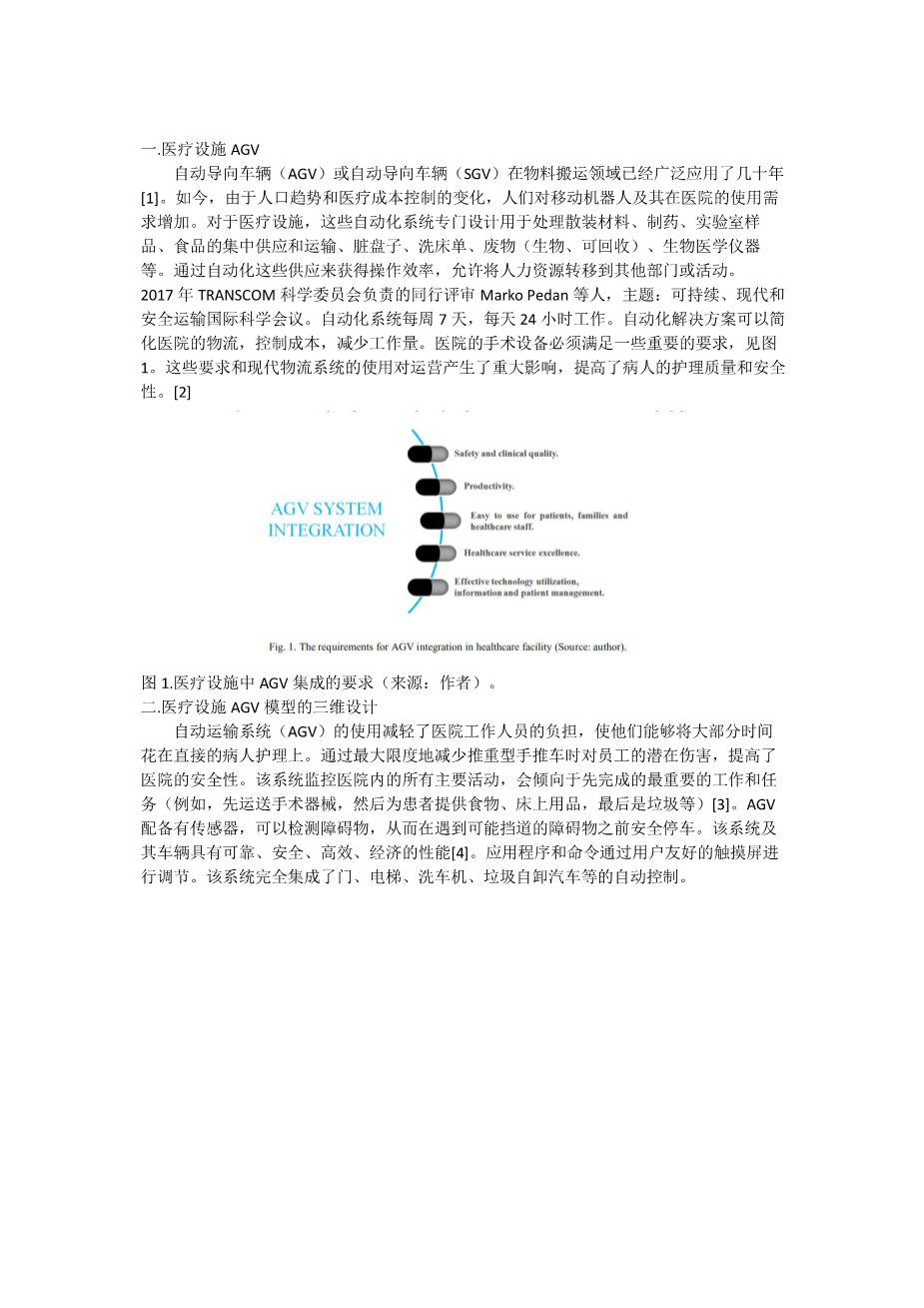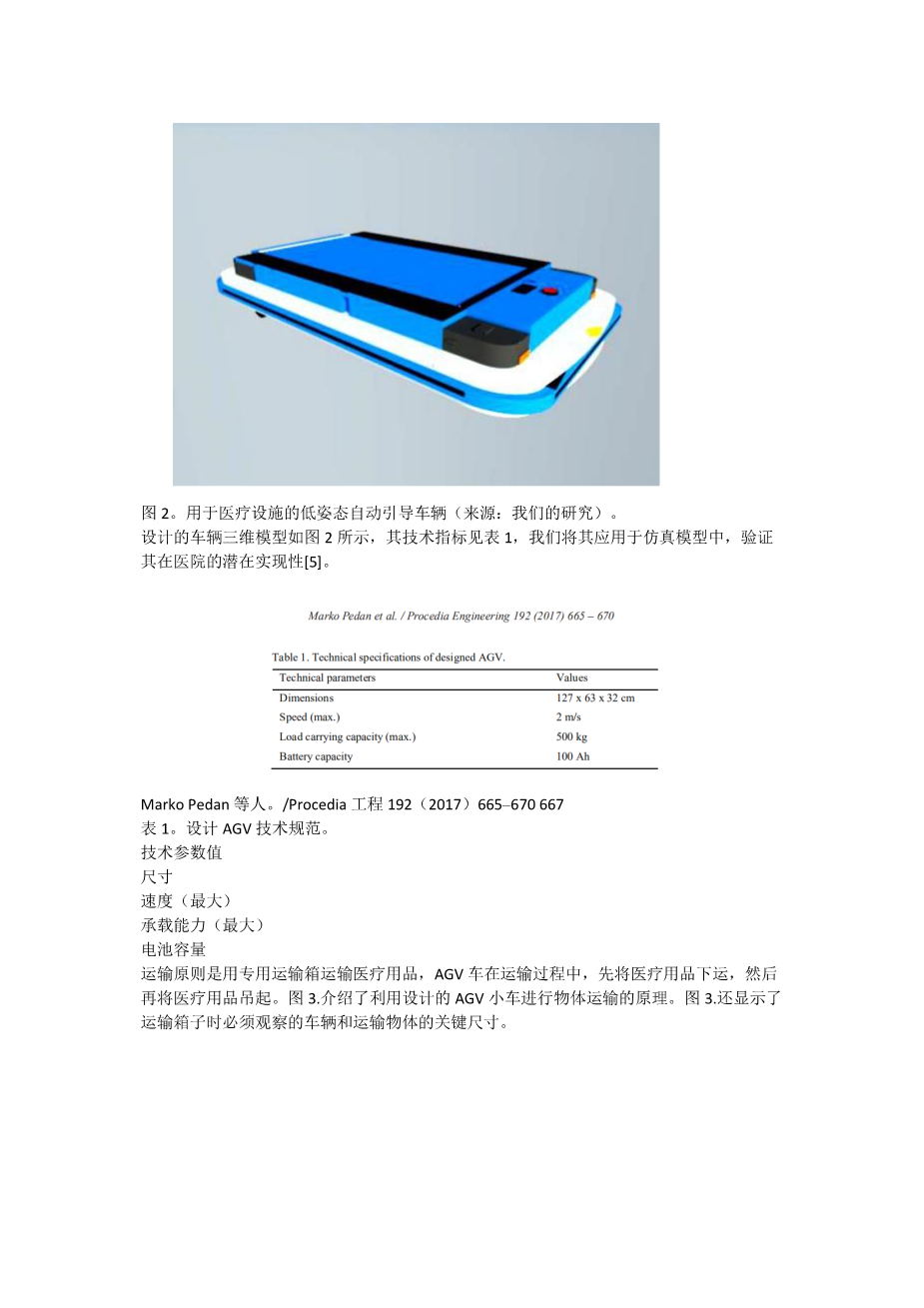1. AGV for healthcare facilities
Automatic Guided Vehicles (AGV) or self-guided vehicles (SGV), have been widely used in material handling for decades[1] . In these days, the demand for mobile robots and their use in hospitals has increased due to changes in demographic trends and medical cost control. For healthcare facilities, these automated systems are designed specifically for handling bulk material, pharmacy medicines, laboratories samples, central supply and transportation of food, dirty dishes, bed laundry, waste (biological, recyclable), biomedical instruments etc. Operating efficiency is gained by automating these supplies, which allows the transfer of human resources to other departments or activities.
Peer-review under responsibility of the scientific committee of TRANSCOM 2017: International scientific conference on sustainable, modern and safe transport
Marko Pedan et al. Automated systems are working 24 hours a day, 7 days a week. Automated solution can streamline traffic flow of material in the hospital, control costs, reduce workload. Hospital operating installation have to fulfill some important requirements, see Fig. 1. These requirements and the use of modern logistics systems significantly affects the operation
of the entire facility and its economy, improves the quality of patient care and increases their safety.[2]
Fig. 1. The requirements for AGV integration in healthcare facility (Source: author).
2. The 3D design of AGV model for healthcare facilities
The use of automated transport system (AGV) relieves hospital staff and allows them to spend most of their time on direct patient care. This increases safety in the hospital by minimizing potential injury to the staff when pushing heavy carts. The system monitors all major movements in the hospital and may prefer the most important jobs and tasks that can be completed first (e.g. surgical instruments transported first, then food for patients, bedding, eventually garbage, etc.) [3]. AGV is equipped with sensors to detect obstacles that allow safe stop before hitting obstacles that might be in the way. The system and its vehicles is reliable, safe, efficient and cost-effective [4]. Applications and commands are mediated through a user-friendly touch screen. The system is fully integrated for automatic control of doors, elevators, trolley washers, garbage dump truck, etc.
Fig. 2. Low profile Automated Guided Vehicle for healthcare facilities (Source: our research).
This designed 3D model of vehicle, see Fig. 2., has technical specifications specified in Table 1, and we will use it in the simulation model, which verifies its potential implementation in the hospital [5].
Marko Pedan et al. / Procedia Engineering 192 ( 2017 ) 665 – 670 667
Table 1. Technical specifications of designed AGV.
Technical parameters Values
Dimensions
Speed (max.)
Load carrying capacity (max.)
Battery capacity
The transport principle will be carried out in such a way that the medical supplies will be transported by special transport boxes that AGV cart undercuts and then lifts up. Fig. 3. describes the principle of object transportation using designed AGV cart. Fig. 3. also shows the key dimensions of the vehicle and transported objects which are necessary to be observed when transporting boxes.
Fig. 3. The minimum dimensions of the transport box and the distance between the vehicle and transport box (Source: our research).
3. AGV implementation in a ward of healthcare facility.
In selected healthcare facility we designed AGV integration in the following areas [6]:
Food transportation to the patient rooms. This process represents the provision of food transportation from the food arrival, which provides the external company, to the food transportation provided by AGVs to the kitchen, then sorting the meals for patients by healthcare staff and distributing the meals by AGVs to the patient rooms.
The rooms have designed areas for precise stopping and unloading food from AGVs.
Collection and transportation of used and clean laundry. Healthcare facility has their external company, which carries away and washes the dirty laundry and delivers the clean one back. The facility can use AGVs for the internal transport service. Transportation would consist of loading the laundry box and transporting it to the desired location (central storage). Transportation through the floors will be carried by freight elevator.
Waste transportation. Waste will be transported from a well-marked spaces and areas from the whole ward.
The waste will be collected on these places in special boxes. The AGVs will then take and move the waste to thetemporary storage of waste to the base floor.
668 Marko Pedan et al.
3.1. The visualization of AGV integration in simulation software SIMIO
We used simulation software for verification of our suggested implementations of AGVs in inpatient ward. For this purpose, we used software Simio in which we have imported the real objects and the physical disposition of healthcare facility. Fig. 4. shows the transportation process of food in the ward in digital environment [5,6]. AGVs in this simulation software follows the inpatient ward streams that we have mapped and analyzed (i.e. the movement of
medical staff and medical material). Transport between the floors will be carried by freight elevator, see Fig. 4a. AGVs will then transport the food to a designated locations in patient rooms [7], see Fig. 4b.
Fig. 4. (a) food transportation to the inpatient ward by freight elevator; food unloading in patient room (Source: our research).
3.2. Simulation as a decision-making tool
Simulation in healthcare can be considered as an effective tool, technique or method [8]. Healthcare personnel especially decision makers - direct
剩余内容已隐藏,支付完成后下载完整资料


英语译文共 15 页,剩余内容已隐藏,支付完成后下载完整资料
资料编号:[413937],资料为PDF文档或Word文档,PDF文档可免费转换为Word
以上是毕业论文外文翻译,课题毕业论文、任务书、文献综述、开题报告、程序设计、图纸设计等资料可联系客服协助查找。


